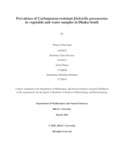Prevalence of Carbapenem-resistant Klebsiella pneumoniae in vegetable and water samples in Dhaka South
Abstract
Carbapenems are commonly considered last-resort antibiotics in the treatment of severe infections
caused by multidrug-resistant Enterobacteriaceae. The emergence of carbapenem-resistant
isolates over the last decade has been a major concern as it has contributed to narrowing the current
treatment palette, leaving few or in some cases optimal treatment options. The present research
was done to isolate and assess the prevalence of carbapenem-resistant Klebsiella pneumoniae in
vegetable and water samples from hospital adjacent areas in Dhaka South. In this study, 55
vegetable and 50 water samples were randomly collected from different local markets near
hospitals in Dhaka South. These samples were collected from September 2021 to November 2021.
Out of 606 strains isolated throughout the study (from both enrichment and without enrichment
cultures), 77 (12.71%) were Klebsiella pneumoniae. These isolates were subjected to an antibiotic
susceptibility test using the following 12 antibiotics; Meropenem+EDTA (MR+ED), Imipenem
(IMI10), Kanamycin(K30), Gentamicin (CN10), Ceftazidime (CAZ30), Erythromycin(E15),
Nitrofurantoin (NIT300), Ampicillin (AMP10), Amoxyclav (AMC30), Nalidixic acid (NA30),
Streptomycin(S10), and Tetracycline (TE30). All the 77 Klebsiella pneumoniae isolates were
found to be resistant to Meropenem + EDTA (100%), followed by Nalidix Acid and Erythromycin
to which 72.70% and 63.60% were resistant, respectively. This was then followed by Kanamycin
(57.10%), Ampicillin (55.80%), Ceftazidime (51.90%), Nitrofurantoin (49.40%), Tetracycline
(33.80%), Streptomycin (18.20%), Imipenem (15.60%), Gentamicin (10.40%) and Amoxyclav
(7.80%). 4 (5.19%) of the K. pneumoniae isolates were resistant to all the 12 tested antibiotics.
When the Multiple Antibiotic Resistance (MAR) index was calculated, 5(6.49%), 39(50.65%),
29(37.66%), and 4(5.19%) were identified under MAR indices <0.2, 0.2-<0.5, 0.5-<1 and 1
respectively.
PCR was used to detect carbapenemase genes; blaNDM-1 and blaOXA-2 in 59 DNA-extracted K.
pneumoniae isolates. 5(8.47%) of the isolates were positive for the blaNDM-1 gene, out of which, 3
and 2 came from samples collected from Anandabazar and Moulovibazar respectively. On the
other hand, 9(15.25%) of the isolates were positive for the blaOXA-2 gene, out of which, 5, 3, and 1
came from samples collected from Anandabazar, Moulovibazar, and Moghbazar respectively. The
findings of the current study demonstrated the potential of vegetables and water from markets
located in hospital adjacent areas of Dhaka South, to be reservoirs of carbapenem-resistant -
multidrug-resistant bacteria

